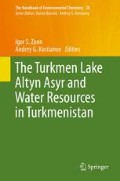Abstract
The idea to use the water of the Amudarya River for irrigation of the Karakum Desert was shaped in the eighteenth century and it was partially realized during the tsarist time in Russia. But only in the 1950s the Karakum Canal, the world’s major hydraulic engineering project, was designed and constructed. After Turkmenistan became an independent state this canal was renamed Karakum River. The artificial Karakum River (“outflow” from the Amudarya by analogy with inflow) connected Amudarya, Murghab, and Tedzhen rivers into a single water system making the basis for economic development of the country. This artificial river permitted to extend the irrigated lands for growing cotton, fodder crops, vegetables, and melon crops; to create fishery farms; to water desert pastures and, accordingly, stimulate development of distant-range grazing of cattle; to develop shipping and use the waters of this river in industry and power engineering.
Access this chapter
Tax calculation will be finalised at checkout
Purchases are for personal use only
Notes
- 1.
Nisa was the capital of Parthia and its spiritual center and, at the same time, the core of the Parthian Empire. It occupied two uplands close to the present-day settlement of Batir 18 km from Ashgabat which was, probably, a satellite of Nisa.
References
Tsinzerling VV (1927) Irrigation in the Amudarya Basin. Publishing House of the Water Management Board of Central Asia, Moscow, USSR (in Russian)
Zhmuida VB (1951) Main Turkmen Canal. Geografgiz, Moscow (in Russian)
Grinberg LM (1965) The Karakum Canal. Ashgabad, Ylym (in Russian)
Orlovsky NS (1999) Creeping environmental changes in the Karakum Canal zone of impact. In: Glantz MH (ed) Creeping environmental problems and sustainable development in the Aral Sea Basin. Cambridge University Press, Cambridge
Brummell P (2005) Turkmenistan. The Bradt travel guide. The Globe Pequot Press, Connecticut, USA
Yanshin AL, Melua AI (1991) Lessons of environmental errors. Mysl, Moscow (in Russian)
National Environmental Action plan by the President of Turkmenistan Saparmurat Turkmenbashi on Environment Protection in Turkmenistan, Ashgabat (2002), Mega, Turkey
Sustainable Development of Turkmenistan. RIO+10. National Report. 2002, Ashgabad (in Russian)
Author information
Authors and Affiliations
Corresponding author
Editor information
Editors and Affiliations
Rights and permissions
Copyright information
© 2012 Springer-Verlag Berlin Heidelberg
About this chapter
Cite this chapter
Zonn, I.S. (2012). Karakum Canal: Artificial River in a Desert. In: Zonn, I., Kostianoy, A. (eds) The Turkmen Lake Altyn Asyr and Water Resources in Turkmenistan. The Handbook of Environmental Chemistry, vol 28. Springer, Berlin, Heidelberg. https://doi.org/10.1007/698_2012_194
Download citation
DOI: https://doi.org/10.1007/698_2012_194
Published:
Publisher Name: Springer, Berlin, Heidelberg
Print ISBN: 978-3-642-38606-0
Online ISBN: 978-3-642-38607-7
eBook Packages: Earth and Environmental ScienceEarth and Environmental Science (R0)

